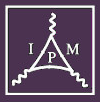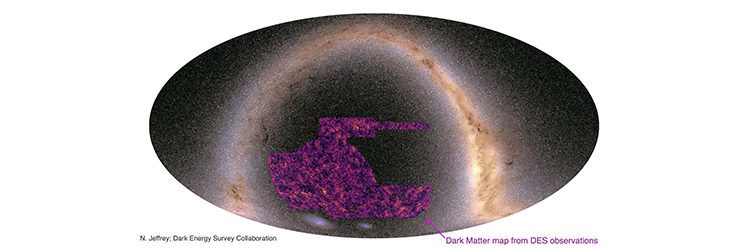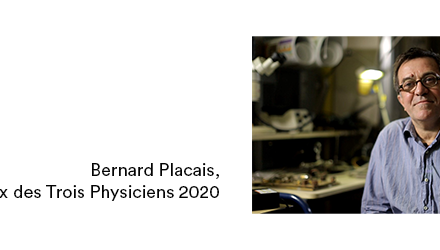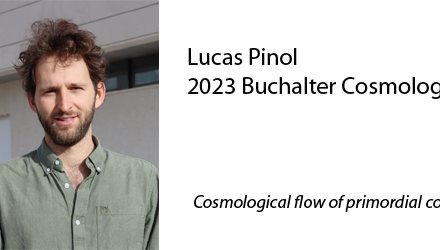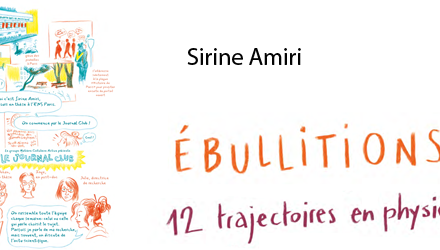ENS scientists have co-led the creation of the largest ever map of invisible dark matter using gravitational lensing. These new Dark Energy Survey (DES) results are described in a paper to be published in the Monthly Notices of the Royal Astronomical Society.
Co-lead author Dr Niall Jeffrey (LPENS & UCL) said: “Most of the matter in the Universe is dark matter. It is a real wonder to get a glimpse of these vast, hidden structures across a large portion of the night sky. These structures are revealed using the distorted shapes of hundreds of millions of distant galaxies with photographs from the Dark Energy Camera in Chile.”
“Observing these cosmic-scale structures can help us to answer fundamental questions about the Universe.”
Even though we cannot see dark matter, its gravity bends light and makes galaxies appear to present a specific pattern across the sky. Using images of over a hundred million galaxies, scientists have used this effect, called gravitational lensing, to unveil a map of previously invisible dark matter. The new map covers a quarter of the sky of the Southern Hemisphere.
The technique of using this pattern of galaxy shapes to reveal dark matter was first demonstrated in 1993 by Prof. Nick Kaiser (ENS), who said: “Earlier measurements of this kind had shown the huge promise of this technique, but were really very limited in the area that could be covered.”
He added: “The new data are a huge advance on what was possible before, and Niall and the DES collaboration team have done a wonderful job in carefully measuring the shapes of millions of galaxies and generating these maps of the dark matter, which will lead to important constraints on theories for the origin of the Universe.”
The method first described by Prof. Kaiser are now being developed further, aided by new AI-inspired statistical methods. Future breakthroughs of data-science are being made by ENS scientists in collaboration with researchers from across the world, that will continue to help reveal the cosmos.
This new dark matter map covers the largest sky area of any such map and will continue to be the largest until the next generation of experiments. The ESA Euclid mission, due to be launched in the coming years, will use a space telescope to photograph galaxies with unprecedented quality. As a leading participant in this project, France (via CNES) has provided the laboratories with around 500 Euclid members in France – including the scientific manager of the mission (Yannick Mellier) and his deputy (Francis Bernardeau). By measuring over 1 billion galaxies, Euclid will create the next generation of dark matter maps covering almost half of the night sky.
About DES
The Dark Energy Survey (DES) is an international effort to observe hundreds of millions of galaxies. DES began observing distant galaxies Southern skies in 2013 using a highly-sensitive 570 Megapixel camera, DECam, mounted at the Blanco Telescope of the Cerro Tololo Inter-American Observatory in the mountains of Chile.
The international project of over 400 scientists aims to measure the composition and growth of the Universe and to better understand dark matter and dark energy, which is thought to be driving the Universe’s accelerating expansion.

Largest ever dark matter map from the Dark Energy Survey
Caption: With the new dark matter map from DES, astronomers are able to explore the connection between dark matter and visible galaxies. By observing the matter shown by the map, a web-like structure with dense clumps of matter separated by large empty voids, scientists can enhance the understanding of the laws that govern our Universe.
credit: N. Jeffrey / Dark Energy Survey collaboration.
More :
Niall Jeffrey, Marco Gatti et al, “Dark Energy Survey Year 3 results: curved-sky weak lensing mass map reconstruction”. Accepted by Monthly Notices of the Royal Astronomical Society | https://www.darkenergysurvey.org/des-year-3-cosmology-results-papers
BBC : https://www.bbc.co.uk/news/science-environment-57244708
The Guardian : https://www.theguardian.com/science/2021/may/27/astronomers-create-largest-map-universe-dark-matter-einstein
BBC News :
Author affiliation :
Laboratoire de Physique de L’École normale supérieure (LPENS, ENS Paris/CNRS/Sorbonne Université/Université de Paris)
Corresponding author : Niall Jeffrey
Communication contact : L’équipe de communication









